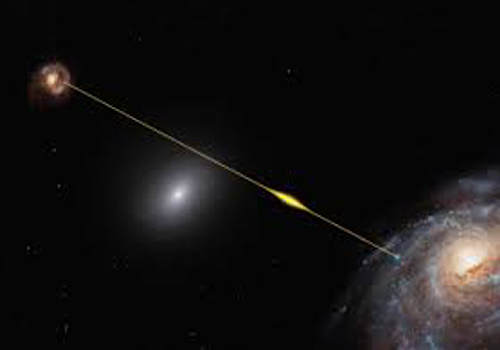It seemed at times that just about anything could — and did — happen in 2020, so it’s kind of fitting that a once-in-a-lifetime pandemic would share the spotlight with a long-standing cosmic mystery.
“My first reaction was, ‘This is weird but also amazing,’” says Dunlap Institute for Astronomy & Astrophysics Fellow Paul Scholz, referring to Science Magazine ranking his research on fast radio bursts (FRBs) second only to COVID-19 vaccines as the biggest breakthrough of 2020.
FRBs are brief but powerful flashes of radio waves that have confounded astronomers since their discovery more than a decade ago, generating scores of theories about their source.
Scholz and his team may have gone a long way to solving that mystery by discovering an FRB right here in our own Milky Way, tens of thousands of light-years closer than any detected before.
The source was magnetar SGR 1935+2154, a neutron star with a powerful magnetic field in the constellation Vulpecula (the Fox), about 10,000 light-years away.

In a year full of surreal circumstances, Scholz led the astrophysical detective work from his basement.
“We detected the event in April and then there was all this press excitement, and I was thinking what an incredible discovery this was to make from home, me in my basement and everyone else in their various workspaces,” says Scholz.
Magnetar SGR 1935+2154 is in the same constellation in which the first pulsar was detected in 1967. Pulsars are highly compact neutron or white dwarf stars that emit beams of electromagnetic radiation from their poles.
“We certainly weren't expecting to detect an FRB event from a source within our galaxy, even though we always knew that was a possibility. That makes it much easier to study, even if it’s a surprise.”
Popular media had speculated that FRBs might be signals from extraterrestrial intelligence because of their mysterious and repeating nature, like some far-off civilization trying to send a message.
“It certainly got a lot of people excited, but astronomers always knew there was some sort of natural explanation, even though for a long time there were more theories and models than there were FRB events themselves,” says Scholz.
The discovery made by Scholz and his team is just the latest example of the Faculty of Arts & Science and the University of Toronto being at the forefront of research into FRBs.
Scholz notes the foresight U of T demonstrated by investing in the Canadian Hydrogen Intensity Mapping Experiment (CHIME). The novel radio telescope is a partnership between U of T, the University of British Columbia, McGill University and the Canadian National Research Council’s Dominion Radio Astrophysical Observatory.
In this case, the new FRB was not only detected through the CHIME telescope but also through the 10-metre telescope at the Algonquin Radio Observatory – which was primarily constructed by astronomers at U of T. With those instruments working in tandem, the team was able to confirm the discovery.
Pinpointing a likely magnetar source for FRBs in our celestial backyard is a big step, but there are a lot of mysteries remaining, Scholz points out.
“What we detected from SGR 1935+2154 doesn’t quite explain everything we’ve seen from FRBs,” he says.
“For one thing, it’s less energetic than the FRBs we’ve seen coming from halfway across the universe, so it’s hard to imagine getting a burst like that from a magnetar like SGR 1935+2154.”
Another mystery is why — despite years of searching — researchers have only detected this one burst from a magnetar in the Milky Way as opposed to the repeating nature of the FRBs detected much further away.
“We’ll continue to study fast radio bursts and see how that puzzle comes together,” says Scholz.
Whatever questions are left to answer, it is certainly no mystery to Scholz or other researchers why understanding FRBs is so important.
“Advances in physics and science are what give us the amazing standard of living we enjoy today, even though it can be hard for the public to connect those things,” he says.
“But hundreds of years from now, we can look back and see how science put this together.”

